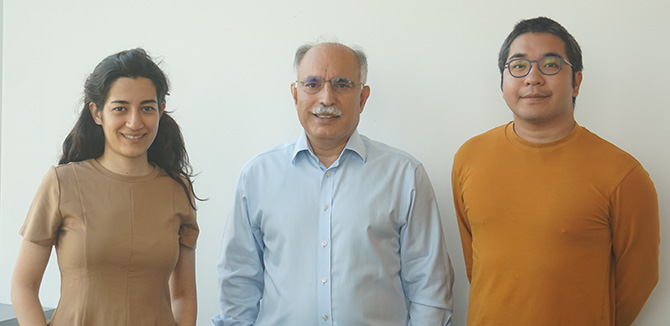Advancing Personalized Medicine Through Computation
MadHitter software identifies cell membrane protein targets for precision cancer treatment
A multi-institution team including Northwestern Engineering’s Samir Khuller, Peter and Adrienne Barris Chair of Computer Science, Saba Ahmadi and Pattara Sukprasert developed software called MadHitter that employs a computational optimization technique to identify cell membrane protein targets for precision cancer treatment.
Published in Nature Communications, the study “The Landscape of Receptor-mediated Precision Cancer Combination Therapy via a Single-cell Perspective,” combines research in cancer genomics, computer science, physical chemistry, and microeconomics.
Ahmadi, a postdoctoral researcher at the Toyota Technological Institute, is a former visiting scholar at Northwestern Engineering Computer Science advised by Khuller. She earned her PhD in computer science from the University of Maryland, College Park.
Sukprasert is a PhD candidate in computer science at the McCormick School of Engineering advised by Khuller. Previously, Khuller advised both Ahmadi and Sukprasert in the master of science in computer science program at the University of Maryland, College Park.
In 2019, Khuller, Ahmadi, and Sukprasert met with project leads Alejandro A. Schäffer and Eytan Ruppin of the Cancer Data Science Laboratory, National Cancer Institute, to discuss the translational questions that formed the basis of the study.
“Our ultimate goal is to design safe and effective personalized medicine to treat cancer one patient at a time,” Ahmadi said. “If patients had their single-cell gene expression measured in both cancer and non-cancer cells of the tumor microenvironment, then those single-cell gene expression measurements could be used to guide personalized treatment.”
“This work is a great example of how cross-discipline collaborations can result in great work with impact to human health,” Khuller said. “We were all fortunate to be able to partner with the top data science lab in the country and my students benefited greatly from the mentoring by Alejandro and Eytan.”
The MadHitter computational approach determined promising over-expressed protein targets for the development of combination therapies to selectively kill most tumor cells while sparing most of the non-cancerous cells in several cancer types. Physical chemistry modeling of receptor-ligand interactions conducted by Tine Curk, a postdoctoral researcher in materials science and engineering at Northwestern Engineering, is cited in the paper and justifies one aspect of the methodology.
The team ran the software on nine, single-cell gene-expression data sets representing more than 50 patients.
“We learned that, for most cancer types with up to four targets, 80 percent of tumor cells can be killed, and 90 percent of non-tumor cells can be spared,” Sukprasert said.
Ahmadi explained that tumor and non-tumor cells share common cell membrane proteins.
“The challenge is to identify combinations of genes that are over-expressed in most tumor cells, but in very few non-tumor cells,” Sukprasert said. “Our task is to choose as few drugs as possible so that most tumor cells are likely to be targeted and most non-tumor cells are unlikely to be hit and we studied this problem through a computational lens.”
The technique, combinatorial optimization, aims to efficiently find a provably best solution within an exponentially large set of possible solutions.
“The name MadHitter is a combination of riffs on the hitting set problem in combinatorial optimization and the Mad Hatter character in Lewis Carroll’s Alice in Wonderland,” Ahmadi said. “As the Mad Hatter helped Alice look both backwards and forwards in her looking glass, the motivating goal of our project was to look back and combine existing research tools from disparate fields to help cancer researchers imagine a different vision of the future of personalized oncology.”
The investigators presented an abstract framework that covers four types of modular cancer therapies: CAR-T therapy, chemotherapy drugs conjugated to antibodies, chemotherapy drugs packed inside nanoparticles with ligand-mimicking peptides, and degraders.
“The key concept that unifies these four very different types of drugs is that the part of the drug that recognizes the cell to kill is separate from the part of the drug that actually kills the cell,” Sukprasert said. “Thus, we can imagine combining distinct drugs with different cell recognition subunits and the same cell killing subunits.”
As a result of the study, the team proposed the adoption of single-cell technology for clinical use in cancer treatment.
“At this time, single-cell data are collected only for basic science purposes because the experiments are slow and expensive, but in actuality one single-cell experiment costs much less than the average cost of treating a single-cancer patient for one year under a typical research protocol,” Ahmadi said.
The study is a collaboration between researchers at Northwestern Engineering; the National Institutes of Health’s National Cancer Institute, the University of Maryland, College Park; and Brigham and Women’s Hospital.

